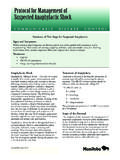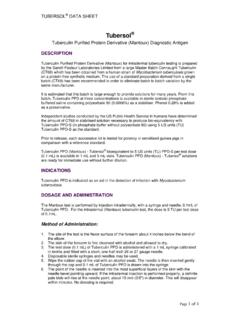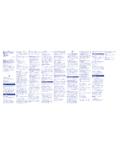Transcription of WHO MODEL FORMULARY - World Health Organization
1 WHO MODEL FORMULARY 2008 WHO Library Cataloguing-in-Publication Data : World Health Organization WHO MODEL FORMULARY 2008 / editors, Marc C. Stuart, Maria Kouimtzi, Suzanne R. Hill. - standards. 2. Essential drugs. 3. Pharmaceutical preparations -administration and dosage. , Marc C. , Maria. , Suzanne. ISBN 978 92 4 154765 9 (NLM classification: QV 50) World Health Organization 2009 All rights reserved. Publications of the World Health Organization can be obtained from WHO Press, World Health Organization , 20 Avenue Appia, 1211 Geneva 27, Switzerland (tel.: +41 22 791 3264; fax: +41 22 791 4857; e-mail: Requests for permission to reproduce or translate WHO publications whether for sale or for noncommercial distribution should be addressed to WHO Press, at the above address (fax: +41 22 791 4806; e-mail: The designations employed and the presentation of the material in this publication do not imply the expression of any opinion whatsoever on the part of the World Health Organization concerning the legal status of any country, territory, city or area or of its authorities, or concerning the delimitation of its frontiers or boundaries.))
2 Dotted lines on maps represent approximate border lines for which there may not yet be full agreement. The mention of specific companies or of certain manufacturers products does not imply that they are endorsed or recommended by the World Health Organization in preference to others of a similar nature that are not mentioned. Errors and omissions excepted, the names of proprietary products are distinguished by initial capital letters. All reasonable precautions have been taken by the World Health Organization to verify the information contained in this publication. However, the published material is being distributed without warranty of any kind, either expressed or implied.
3 The responsibility for the interpretation and use of the material lies with the reader. In no event shall the World Health Organization be liable for damages arising from its use. The named editors alone are responsible for the views expressed in this publication. Printed in Switzerland WHO MODEL FORMULARY 2008 iiiEditors Mark C. Stuart Maria Kouimtzi Suzanne R. Hill, Department of Essential Medicines and Pharmaceutical Policies, World Health Organization , Geneva Acknowledgements Sincere thanks for their contributions and comments on the current edition of the WHO MODEL FORMULARY are due to the following individuals: at WHO, Jorge Alvar, Pilar Aparicio, Catherine d'Arcangues, Philippe Duclos, Olivier Fontaine, Ahmet Metin Gulmezoglu, Matthews Mathai, Shanthi Mendis, Peter Olumese, Shamin Ahmad Qazi, Mario Raviglione, Cathy Roth, Pere Simarro, and Marco Vit ria; and at the Institut Pasteur, Belgium and the International Union of Immunological Societies, Ian Magrath.
4 Special thanks are due to Sangeeta Kakar for her editorial assistance, to Monique Renevier, WHO, for updating and managing the database for the electronic edition, and to J rg Hetzke, WHO, and St phane Louet for developing the web-based solution and database. WHO MODEL FORMULARY 2008 iv WHO MODEL FORMULARY 2008 vContents Abbreviations .. vi Introduction .. vii Changes to the WHO MODEL List of Essential Medicines .. viii General advice to prescribers .. 1 Section 1: Section 2: Analgesics, antipyretics, non-steroidal anti-inflammatory medicines (NSAIMS), medicines used to treat gout and disease modifying agents in rheumatoid disorders (DMARDs)..30 Section 3: Antiallergics and medicines used in anaphylaxis.
5 47 Section 4: Antidotes and other substances used in poisonings ..55 Section 5: Anticonvulsants/antiepileptics ..67 Section 6: Anti-infective medicines ..80 Section 7: Antimigraine medicines ..214 Section 8: Antineoplastic, immunosuppressives and medicines used in palliative care ..219 Section 9: Antiparkinsonism medicines ..241 Section 10. Medicines affecting the Section 11: Blood products and plasma substitutes ..256 Section 12: Cardiovascular medicines ..262 Section 13: Dermatological medicines (topical)..294 Section 14: Diagnostic Section 15: Disinfectants and Section 16: Section 17: Gastrointestinal medicines ..335 Section 18: Hormones, other endocrine medicines and contraceptives ..353 Section 19: Section 20: Muscle relaxants (peripherally-acting) and cholinesterase inhibitors.
6 425 Section 21: Ophthalmological preparations ..432 Section 22: Oxytocics and Section 23: Peritoneal dialysis solution ..452 Section 24: Psychotherapeutic medicines ..454 Section 25: Medicines acting on the respiratory tract ..473 Section 26: Solutions correcting water, electrolyte and acid-base disturbances ..486 Section 27: Vitamins and Appendix 1: Appendix 2: Appendix 3: Breastfeeding ..599 Appendix 4: Renal Appendix 5: Hepatic Index ..628 WHO MODEL FORMULARY 2008 vi Abbreviations ACE angiotensin-converting enzyme ADR adverse drug reaction AIDS acquired immunodeficiency syndrome AV atrioventricular BCG Bacille Calmette Gu rin (vaccine)
7 BP British Pharmacopoeia BSA body surface area CNS central nervous system CSF cerebrospinal fluid DOTS directly observed treatment, short-course DMARD disease-modifying agents in rheumatoid disorders ECG electrocardiogram EEG electroencephalogram G6PD glucose 6-phosphate dehydrogenase GFR glomerular filtration rate HIV human immunodeficiency virus HRT hormone replacement therapy INR international normalized
8 Ratio MB multibacillary leprosy MDI metered dose inhaler MDR-TB multidrug-resistant tuberculosis NSAIM non-steroidal anti-inflammatory medicine PB paucibacillary leprosy PTB pulmonary tuberculosis spp. species SSRI selective serotonin reuptake inhibitor TB tuberculosis USP United States Pharmacopeia WHO World Health Organization WHO MODEL FORMULARY 2008 viiIntroduction In 1995, the WHO Expert Committee on the Use of Essential Drugs recommended that WHO develop a MODEL FORMULARY which would complement the WHO MODEL List of Essential Drugs (the MODEL List ).
9 It was considered that such a WHO MODEL FORMULARY would be a useful resource for countries wishing to develop their own national FORMULARY . The WHO MODEL FORMULARY was first published in August 2002. In this edition, we have reverted to the structure and sections used in the WHO MODEL List. Although this may not always reflect ideal therapeutic categories, it has been done as part of the process of updating the entire WHO Medicines Library, which now has one interlinked structure that includes the FORMULARY information as well as other information about the listed medicines. Countries or organizations which choose to adapt the MODEL FORMULARY for their own purposes may wish to adjust the structure to suit their needs.
10 The WHO MODEL List and the WHO MODEL FORMULARY are available electronically on the WHO Essential Medicines Library web site ( ); search facilities provide easy access to relevant information. An electronic version of the WHO MODEL FORMULARY is also available, intended as a starting point for developing national or institutional formularies. National or institutional committees can use the text of the WHO MODEL FORMULARY for their own needs either by adapting the text, or by adding or deleting entries to align the FORMULARY to their own list of essential medicines. This edition of the WHO MODEL FORMULARY is fully compatible with the 15th WHO MODEL List of Essential Medicines as recommended by the WHO Expert Committee on the Selection and Use of Essential Medicines at its meeting of March 2007.















